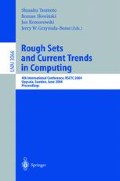Abstract
In this paper, we give a general treatment for some kind of sequences such as customer sequences, document sequences, and DNA sequences, etc. Large collections of transaction, document, and genomic information have been accumulated in recent years, and embedded latently in it there is potentially significant knowledge for exploitation in the retailing industry, in information retrieval, in medicine and in the pharmaceutical industry, respectively. The approach taken here to the distillation of such knowledge is to detect strings in sequences which appear frequently, either within a given sequence (eg for a particular customer, document, or patient) or across sequences (eg from different customers, documents, or patients sharing a particular transaction, information retrieval, or medical diagnosis; respectively).
Access this chapter
Tax calculation will be finalised at checkout
Purchases are for personal use only
Preview
Unable to display preview. Download preview PDF.
References
Agrawal, R., Srikant, R.: Mining sequential patterns. In: Proceedings of the 11th International Conference on Data Engineering, Taipei, Taiwan, March 1995, (1994-1995); IBM Research Report RJ 9910 (October 1994) (expanded version)
Bell, D.A., Guan, J.W.: Computational methods for rough classification and discovery. Journal of the American Society for Information Science, Special Topic Issue on Data Mining 49(5), 403–414 (1998)
Bell, D.A., Guan, J.W.: Data mining for motifs in DNA sequences. In: Wang, G., et al. (eds.) Proceedings of the 9th International Conference on Rough Sets, Fuzzy Sets, Data Mining and Granular Computing (RSFDGrC 2003), Chongqing, China, October 19-22 (2003)
Feldman, R., Aumann, Y., Amir, A., Zilberstain, A., Kloesgen, W., Ben-Yehuda, Y.: Maximal association rules: a new tool for mining for keyword co-occurrences in document collection. In: Proceedings of the 3rd International Conference on Knowledge Discovery (KDD 1997), pp. 167–170 (1997)
Frawley, W.J., Piatetsky-Shapiro, G., Matheus, C.J.: Knowledge discovery in databases: an overview. In: Piatetsky-Shapiro, G., Frawley, W.J. (eds.) Knowledge Discovery in Databases, pp. 1–27. AAAI/MIT Press (1991)
Guan, J.W., Bell, D.A.: Rough computational methods for information systems. Artificial Intelligence – An International Journal 105, 77–104 (1998)
Kiem, H., Phuc, D.: Discovering motif based association rules in a set of DNA sequences. In: Ziarko, W.P., Yao, Y. (eds.) RSCTC 2000. LNCS (LNAI), vol. 2005, pp. 348–352. Springer, Heidelberg (2001) ISBN 0828-3494, ISBN 0-7731-0413-5
Pawlak, Z.: Rough sets: theoretical aspects of reasoning about data. Kluwer, Dordrecht (1991)
Srikant, R., Agrawal, R.: Mining sequential patterns: generalizations and performance improvements. In: Apers, P.M.G., Bouzeghoub, M., Gardarin, G. (eds.) EDBT 1996. LNCS, vol. 1057, Springer, Heidelberg (1996); IBM Research Report RJ 9994 (December 1995) (expanded version)
Author information
Authors and Affiliations
Editor information
Editors and Affiliations
Rights and permissions
Copyright information
© 2004 Springer-Verlag Berlin Heidelberg
About this paper
Cite this paper
Guan, J.W., Bell, D.A., Liu, D. (2004). Discovering Maximal Frequent Patterns in Sequence Groups. In: Tsumoto, S., Słowiński, R., Komorowski, J., Grzymała-Busse, J.W. (eds) Rough Sets and Current Trends in Computing. RSCTC 2004. Lecture Notes in Computer Science(), vol 3066. Springer, Berlin, Heidelberg. https://doi.org/10.1007/978-3-540-25929-9_74
Download citation
DOI: https://doi.org/10.1007/978-3-540-25929-9_74
Publisher Name: Springer, Berlin, Heidelberg
Print ISBN: 978-3-540-22117-3
Online ISBN: 978-3-540-25929-9
eBook Packages: Springer Book Archive

